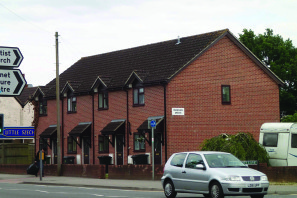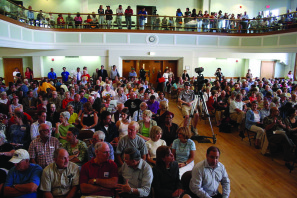We trialled this activity with Years 2, 4 and 5 (age 6 – 10) from two quite different schools. One is a small rural school in an affluent area (school 1), and the other is a much larger urban school, with a higher proportion of pupils from disadvantaged backgrounds (school 2). The two schools have one head teacher and the staff and pupils are used to working together.
We divided pupils into small groups, and this activity formed part of a carousel of 12 activities in total. Each group had about four minutes to complete the activity before moving on to the next one. We were particularly interested in tracking any differences between pupils at the two schools, and between the genders. So we took note of which pupils gave which answers. We organised the pupils into groups of all girls, groups of all boys and mixed groups and noted down the make-up of the group when recording responses.
The two categories that were the most interesting from these two schools were around Housing and Schools.
| Theme | Photo card | School 1 | School 2 |
| Housing | 14. Expensive houses | 4 | |
| 15. Houses everyone can afford | 5 | 3 | |
| 20. Hostel for the homeless | 29 | 50 | |
| Schools | 21. School that welcomes everyone | 31 | 39 |
| 22. School with best resources | 16 | ||
| 23. School with good results | 8 | 15 | |
| Transport | 7. Good roads | 1 | 6 |
| 8. Good public transport | 4 | 6 | |
| 9. Safe to walk and cycle | 24 | 60 | |
| Democracy | 17. Told what to do | 2 | 10 |
| 18. Asked for opinion | 13 | 33 | |
| 26. Adults can vote | 5 | 3 | |
| Shopping and food | 4. Local shops | 10 | |
| 5. Big supermarket | 1 | 12 | |
| 6. Grow own food | 10 | 20 | |
| Places to go | 1. Safe places to play | 4 | 6 |
| 2. Shopping mall | 1 | ||
| 3. Worship your religion | 3 | 12 | |
| 10. Place to meet | 8 | ||
| 19 Green spaces looked after | 1 | 5 | |
| Law | 16. Police are fair | 4 | 8 |
| 25. Criminals in prison | 1 | 2 | |
| 25. Rights are respected | 4 | 2 | |
| 26. Prisoners are helped to stop | 13 | 5 |
The ones with bold text show the most popular responses. The two schools were well-aligned on most responses, differing only with their choices for places to go and relating to the law.
School 1, the small rural school, chose safe places to play over the other choices, whereas school 2 chose a place where you can worship according to your religion.
School 1 chose a place where the police are fair, whereas school 2 favoured a place where criminals are rehabilitated and supported to stop reoffending.
However, the real detail of their attitudes comes from the comments they made during the activity. All of these were recorded as well.
Year 2 (age 6-7) pupils were almost unanimously agreed that a hostel for the homeless was the most important of the choices on housing.
- Because that means they get looked after and don’t live on the street
- People who can’t afford houses can go there
- You don’t have to pay to go in
- They also expressed mature thoughts about growing their own food.
- You don’t need to pay anything
- Because it’s healthy
- No crisps
- You learn how to grow veg
Attitudes from pupils in Years 4 and 5 (age 8-10) were very similar, but obviously better developed.
- Expensive houses have bigger rooms, so the whole family can live there
- People have worked hard to get a house
- Yes but poor people need a home too
- A hostel is like one bog house rather than lots and lots
- You can easily go in to a hostel, but with a house you have to buy it
- People might not have houses
- Because it’s nice to have a place to rest and sleep
- Because homeless people don’t have anywhere to live
Pupils from school 1 unanimously chose a school that welcomes everyone as the most important, whereas school 2 were split 50/50 between a school that welcomes everyone and a school with the best resources.
- If you’re not welcome you wouldn’t want to go there
- If it welcomes everyone it’s good for poor people too – it doesn’t matter what (resources) the school has got
- Lots of people will be inspired to go to that school (21) so people don’t feel left out
- If you’re not welcome then you don’t feel like you belong there
- Best resources because then everyone can go and choose their books all at the same time
- Best resources because then you can learn easily
- Good results aren’t always important eg not in Africa
- Good results – you don’t want to get bad results because then you get a bad job – what about children with special needs? Well there would be good teachers there
Pupils also considered broad ranging options. For example, one group who had chosen a place that is safe to walk and cycle as the most important of the transport options, were then tempted to change their choice when one pupil thought about people with disabilities who can’t walk or cycle, where public transport is then the most important option.
They struggled with the choices around law the most, showing the greatest indecision.
- This one is too hard – it’s all of them
- It’s hard to choose
- If the police are fair to everyone it might mean people going on killing
- If you stop prisoners committing crimes, then you don’t need so many prisons
What this data shows is that even very young pupils have a strong sense of social justice and fairness and can articulate the needs of others, empathising with people that they may have no experience of at all.




